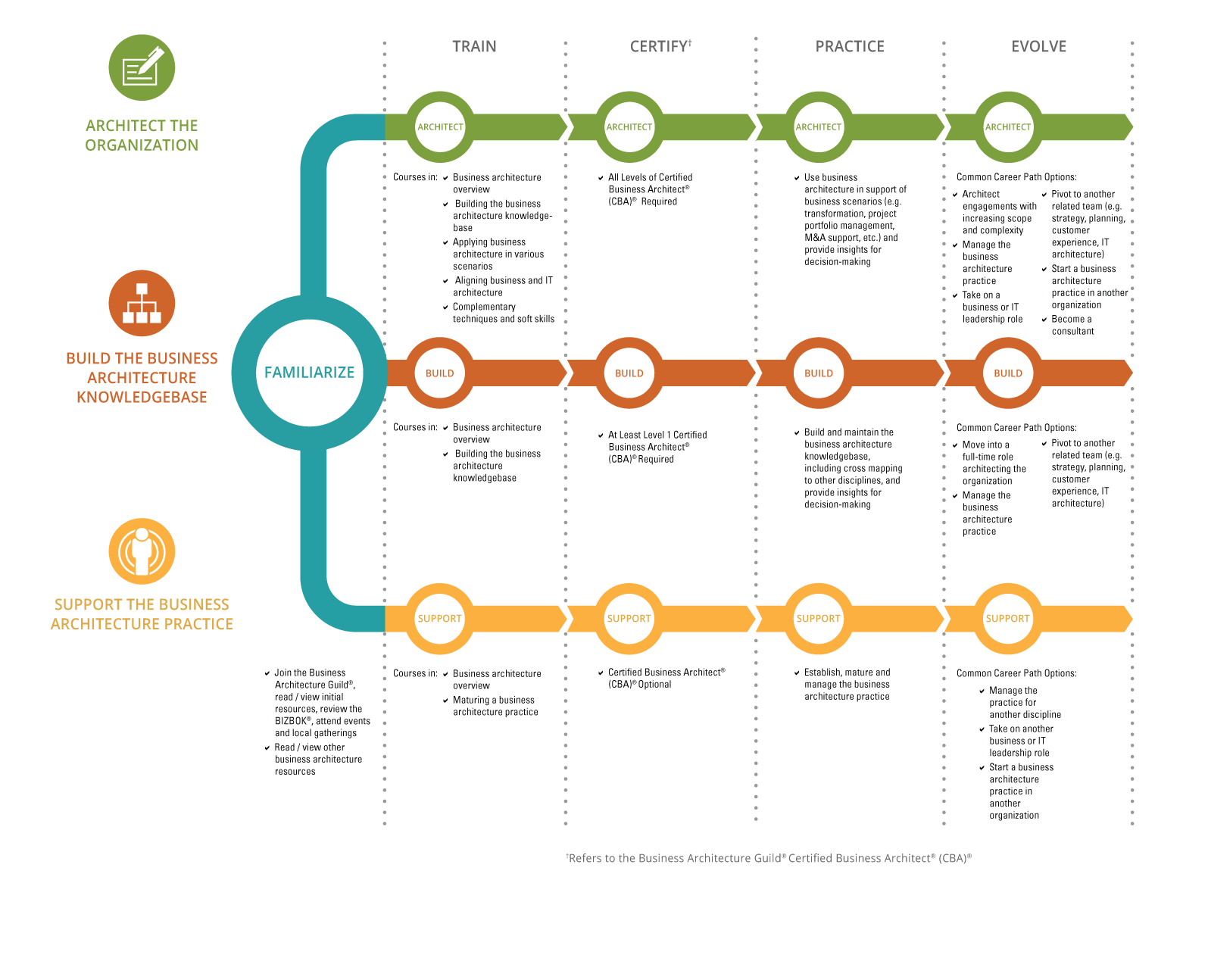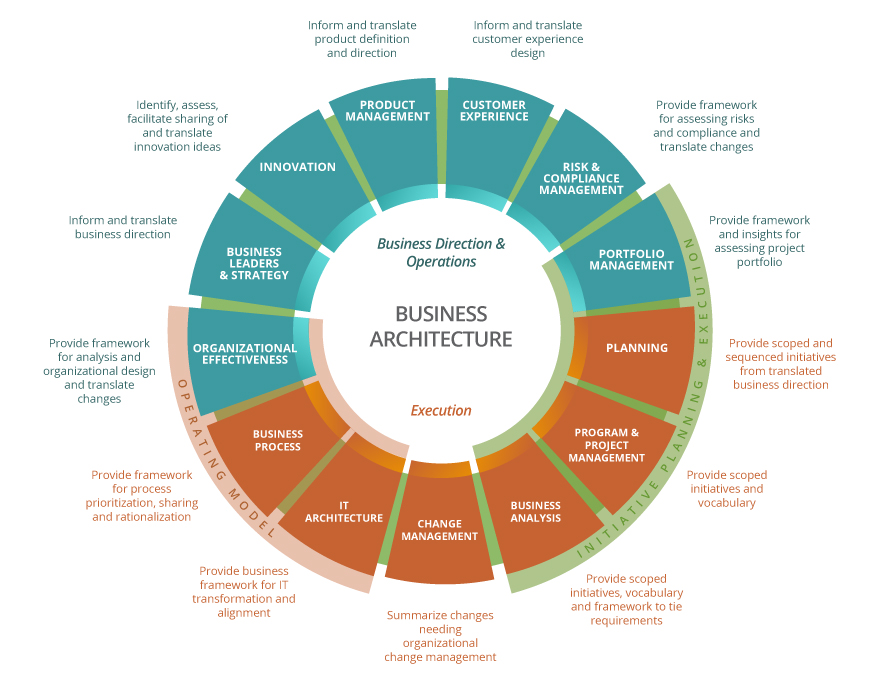
Hey, business architects, you’re the stars of this post. You transform our organizations, make them run better and even design new ones. Here’s to you.
So what does a business architect do anyway?
There are three focus areas of the business architect role in any organization:
- Applying business architecture to various scenarios (a.k.a. “architecting”)
- Building the business architecture knowledgebase
- Creating the business architecture practice infrastructure
A business architect may focus on one, two or all three of these, depending how the role is defined in their organization.
But make no mistake, #1 is the most important thing that business architects do. We actually architect things. And the role has never been more important than it is today because our organizations are constantly changing, especially due to external factors like new customer expectations, the shifting competitive landscape, digital technology and regulation.
But also make no mistake that while #2 and #3 are supporting activities, they are critical to being able to architect with quality, consistency and scale. No #1 without #2 and #3.
P.S. Throwback to Post No. 4 where we discussed that there are always three components to establish business architecture within an organization. Same three as above. Makes sense.
Tell me more about this architecting.
The actual “architecting” that a business architect is responsible for is directly related to how business architecture is intended to be used for a specific organization, just like we talked about in Post No. 2. For example, a business architect might translate strategies (enterprise, business unit, product, digital, etc.) into action or help integrate a newly acquired organization.
Business architects also provide insights and help to facilitate the use of business architecture, such as for project or application portfolio management decision-making.
And one more thing. Scope. Business architects are typically assigned a scope of responsibility for what they architect, which could be for a business unit (vertical), for a set of enterprise capabilities (horizontal) or some other delineation.
Where can I find a job description for a business architect?
While there are lots of descriptions out there, we don’t have an industry standard one to point to just yet. (Keep that in mind as you apply for jobs or hire business architects and remember that we’re talking about a rapidly maturing industry here so there will be inconsistency for a little while.)
But stay tuned. The industry has focused more on defining business architecture and its usage, but we’ll see more of a shift towards the profession and the role over the horizon. In the meantime, know that you can and should adapt the business architect role for your organization. We’ll talk more about this within the context of a business architecture team in the next StraightTalk post.
How do I know if I want to do this or would be any good at it?
Here are juuussstt a few clues to get you started.
You might be an architect if you…
- Think big picture – Like you love bringing people together to facilitate collaboration and build consensus. You are a bridge builder and a dot connector, across teams and across the strategy execution life cycle. And your brain just can’t stop thinking about things like how an idea or solution that works in one part of the organization could work for another.
- Are a structured thinker – Like you think logically and apply structure to challenges and opportunities. You categorize and abstract concepts, and things like “information synthesis” and “visualization” sound like fun to you.
- Care about intentional design – Like you see the value and are passionate about addressing challenges and opportunities architecturally, holistically and collaboratively. And you sort of can’t understand how anyone could not think the same as it makes so much sense in the long term.
What type of experience do I need?
People come to the business architect role from many different perspectives. There’s not just one path to get there and that’s a good thing because it allows the role to be expressed and practiced in different ways. For example, some people worked in a business analyst or an IT role, some were business or IT leaders, or some worked on a complementary team like planning.
What if I’m right out of university or have little professional experience so far?
No problem. There is always a place for you. You will likely work in a role where you are supported by a more experienced business architect. We all have to start somewhere and this is a great place to start your career.
The serious work though, like architecting an enterprise transformation, is typically done by people who are not only highly trained, but also have a wide range of previous professional experience.
Okay, how do I get started then?
We’re here to help. Here’s a handy diagram below that answers just that question, so that you know where to start and what the journey looks like to become a business architect. AND we’ve also compiled a big list of resources (in priority order) to help you learn over time. (See More Good Stuff).

What if I don’t want to become a business architect but am interested in the topic?
No problem! You can leverage your interest in and passion for business architecture in many ways. For example, you could start or manage the business architecture team within your organization (you don’t have to be a business architect). Or, if you work on a complementary team (e.g. strategy, planning, customer experience, business analysis, business process), you could use business architecture and work with business architects. Or, you could simply serve as an advocate for the discipline within your circles.
No matter what you choose to do, you will be our hero.
What about the future?
Once you’ve worked in a business architect role for awhile, it opens up many different opportunities for you. Not only is the business architect role in high demand right now (in many different countries), but your experience will position you well with broad knowledge of your organization, deep relationships and a foundation of structured thinking.
Here are a few things you can do:
- Star in a bigger show – Architect things with increasing complexity and scope (think enterprise-wide or even organizational ecosystem-wide architecting)
- Star in a different show – Move to a complementary team (e.g. strategy, planning, customer experience) or take on a leadership role in the business or IT
Take your show on the road – Go start a new business architecture practice in another organization (maybe don’t tell your boss we said that)
No matter what role or level of engagement you choose to pursue related to business architecture, know that you will be making a difference and positioning yourself for a worthy journey and a bright future.
More good stuff…
![]() Dansk pressemeddelelse: S2E Transformation lancerer bloggen StraightTalk rettet mod forretningsarkitektur-communitiet
Dansk pressemeddelelse: S2E Transformation lancerer bloggen StraightTalk rettet mod forretningsarkitektur-communitiet

